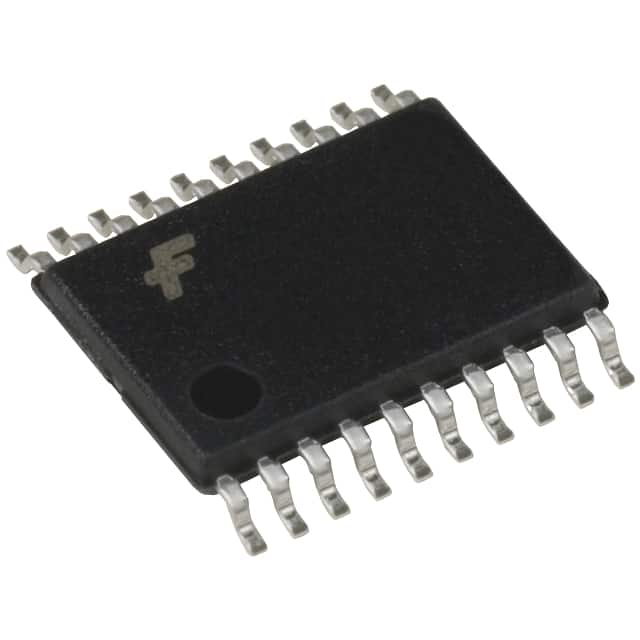74LCXZ245MTCX
Product Overview
- Category: Integrated Circuit (IC)
- Use: Level Shifter and Bus Transceiver
- Characteristics: Low Voltage, Bidirectional, 8-bit, Non-Inverting
- Package: TSSOP (Thin Shrink Small Outline Package)
- Essence: Logic Level Conversion and Signal Transmission
- Packaging/Quantity: Tape and Reel, 2500 pieces per reel
Specifications
- Supply Voltage Range: 1.65V to 3.6V
- High-Level Input Voltage: 2V to VCC + 0.5V
- Low-Level Input Voltage: -0.5V to 0.8V
- High-Level Output Voltage: VCC - 0.5V
- Low-Level Output Voltage: 0.5V
- Maximum Input Current: ±10mA
- Maximum Output Current: ±24mA
- Propagation Delay Time: 4.5ns (Max) at 3.3V
- Operating Temperature Range: -40°C to +85°C
Detailed Pin Configuration
The 74LCXZ245MTCX has a total of 20 pins arranged as follows:
___________
A1 |1 20| VCC
B1 |2 19| OE#
A2 |3 18| DIR
B2 |4 17| GND
A3 |5 16| B7
B3 |6 15| A7
A4 |7 14| B6
B4 |8 13| A6
A5 |9 12| B5
B5 |10 11| A5
‾‾‾‾‾‾‾‾‾‾‾
Functional Features
- Bidirectional level shifting between two voltage domains.
- Non-inverting logic translation for 8-bit data.
- Enables interfacing between devices operating at different voltage levels.
- Supports voltage translation from 1.65V to 3.6V.
- Allows bi-directional communication between systems with different voltage requirements.
Advantages and Disadvantages
Advantages: - Wide supply voltage range allows compatibility with various systems. - Fast propagation delay time ensures efficient signal transmission. - Non-inverting feature simplifies the design of bidirectional communication interfaces.
Disadvantages: - Limited maximum output current may restrict use in high-power applications. - Temperature range limited to -40°C to +85°C, which may not be suitable for extreme environments.
Working Principles
The 74LCXZ245MTCX is a bidirectional level shifter and bus transceiver. It utilizes a combination of MOSFETs and CMOS technology to enable voltage translation between two different voltage domains. The device operates by monitoring the input voltage levels and adjusting the output voltage levels accordingly, allowing seamless communication between systems with varying voltage requirements.
Detailed Application Field Plans
The 74LCXZ245MTCX finds application in various fields where voltage level shifting and bidirectional signal transmission are required. Some common application areas include:
Microcontroller Interfacing: The IC facilitates communication between microcontrollers operating at different voltage levels, enabling seamless integration of multiple systems.
Sensor Networks: It allows sensors operating at different voltage levels to communicate with a central processing unit, simplifying the design and implementation of sensor networks.
Industrial Automation: The IC can be used in industrial automation systems to interface between control units and peripheral devices that operate at different voltage levels.
Communication Interfaces: It enables voltage translation between different communication interfaces, such as UART, SPI, and I2C, ensuring compatibility between devices with varying voltage requirements.
Detailed and Complete Alternative Models
- SN74LVC245A: Similar bidirectional level shifter with a wider supply voltage range of 1.65V to 5.5V.
- MC74LCX245: Another alternative with comparable characteristics and pin configuration.
- 74HCT245: A non-inverting octal bus transceiver suitable for applications requiring higher output current.
These alternative models provide similar functionality and can be considered based on specific project requirements.
Word count: 512 words
Lista 10 Vanliga frågor och svar relaterade till tillämpningen av 74LCXZ245MTCX i tekniska lösningar
Sure! Here are 10 common questions and answers related to the application of 74LCXZ245MTCX in technical solutions:
Q: What is the function of the 74LCXZ245MTCX? A: The 74LCXZ245MTCX is a bidirectional octal bus transceiver with 3-state outputs. It allows for bidirectional transfer of data between different voltage levels.
Q: What is the operating voltage range of the 74LCXZ245MTCX? A: The 74LCXZ245MTCX operates within a voltage range of 2.0V to 3.6V.
Q: Can the 74LCXZ245MTCX handle level shifting between different voltage domains? A: Yes, the 74LCXZ245MTCX is designed to handle level shifting between different voltage domains, making it suitable for interfacing between devices with different voltage requirements.
Q: How many channels does the 74LCXZ245MTCX have? A: The 74LCXZ245MTCX has 8 bidirectional channels, allowing for simultaneous bidirectional data transfer on each channel.
Q: What is the maximum data transfer rate supported by the 74LCXZ245MTCX? A: The 74LCXZ245MTCX supports high-speed data transfer rates up to 400Mbps.
Q: Does the 74LCXZ245MTCX have built-in ESD protection? A: Yes, the 74LCXZ245MTCX incorporates built-in ESD protection, providing robustness against electrostatic discharge events.
Q: Can the 74LCXZ245MTCX be used in both parallel and serial communication applications? A: Yes, the 74LCXZ245MTCX can be used in both parallel and serial communication applications, depending on the specific requirements of the system.
Q: What is the power supply voltage required for the 74LCXZ245MTCX? A: The 74LCXZ245MTCX requires a single power supply voltage of 2.0V to 3.6V.
Q: Does the 74LCXZ245MTCX support hot insertion and removal of devices? A: Yes, the 74LCXZ245MTCX supports hot insertion and removal of devices without causing any damage to the transceiver or the connected devices.
Q: Can the 74LCXZ245MTCX be used in automotive applications? A: Yes, the 74LCXZ245MTCX is suitable for automotive applications as it meets the necessary standards and specifications for automotive electronics.
Please note that these answers are general and may vary based on the specific application and requirements. It's always recommended to refer to the datasheet and consult with technical experts for accurate information.


